
|

|
American Civil War
Date: April 12, 1861—May 12, 1865
Location: Principally in the Southern United States
Result(s): Union victory; Secession defeated; Restoration of the Union; Reconstruction;
Slavery abolished
Combatants: United States of America (Union); Confederate States of America (Confederacy)
Theaters of the American Civil War: Union blockade – Eastern –
Western – Lower Seaboard – Trans-Mississippi – Pacific Coast
| America Civil War |
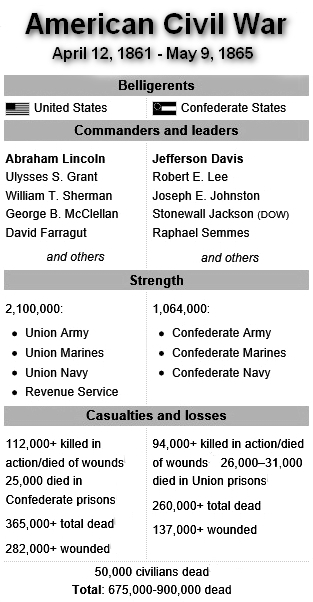
|
| American Civil War |
| American Civil War was Americans Killing Americans |
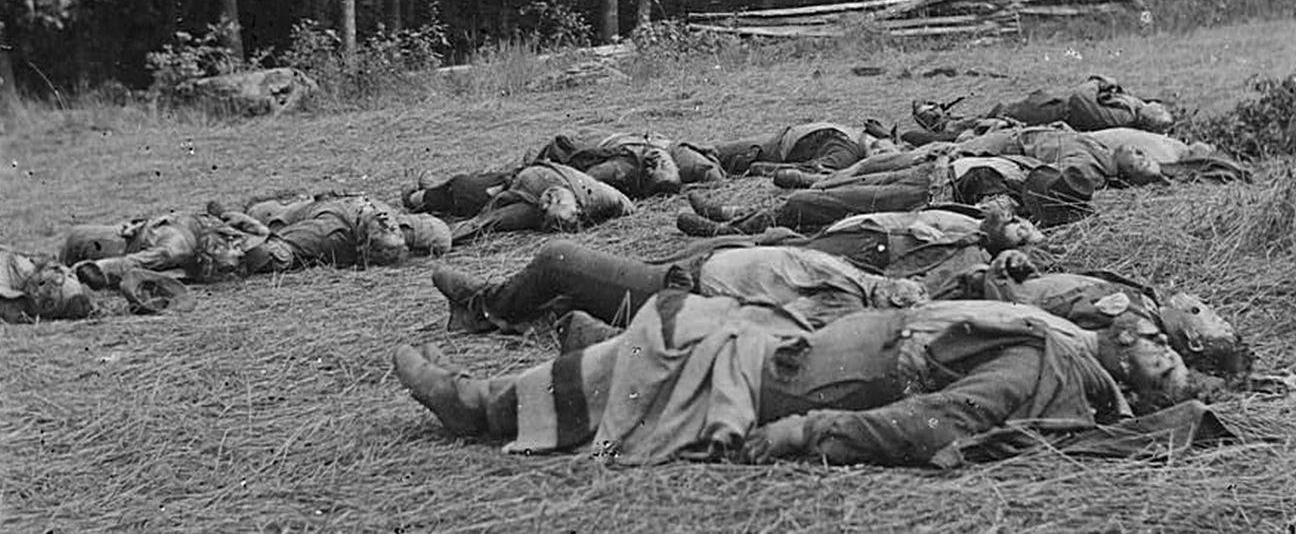
|
| Dead Civil War soldiers at Gettysburg in the war's familiar yet eerie repose |
| American Civil War and its Deadliest Battles |

|
| Top Ten Civil War Battles with Most in Killed and Casualties |
American Civil War (1861–1865) was a major war between the United
States ("Union") and eleven Southern states ("Confederacy"), which declared that they had a right to secession and formed the Confederate States of America, led by President Jefferson Davis.
The Union included free states and Border States and was led by President Abraham Lincoln and the Republican Party. Although the Border States were under Union control,
they supplied the South with tens-of-thousands of troops.
Although the South strongly believed in States' Rights (Bill of Rights and the 10th Amendment) according to the United States Constitution and believed that it entitled them to a right of secession, the Republicans rejected any right of Southern
secession and they opposed the expansion of slavery into territories owned by the United States.
Unlike most international disputes and wars, the Civil War soldier,
whether from the North (Union) or South (Confederacy), had much in common. Some opposing soldiers, for example, including high
ranking generals and lowly privates, spoke the same language, enjoyed the same music, food and hobbies, claimed
the same home state, attended the same university, had the same surname, and were
even raised in the same house. Some soldiers were brothers but found themselves standing firm and on opposing sides of the battlefield, causing many to refer to the conflict as
the Brothers War. Soldiers' motives for fighting in the conflict varied, as well as the war's
causes, divisions, and sectional strife that led to the four year Civil War. See also Causes and Origins of the American Civil War.
Fighting commenced on April 12, 1861, when Confederate forces attacked a
United States (Federal) military installation at Fort Sumter in South Carolina, the first state to secede. South Carolina, however, claimed that Fort Sumter was legally within its (territorial)
waters.
During the American Civil War, the North generally named a battle after
the closest river, stream or creek, and the South tended to name battles after towns or railroad junctions. Hence the Confederate
name Manassas after Manassas Junction, and the Union name Bull Run for the stream Bull Run. Although a Civil War battlefield sometimes extended
for several miles and hosted several battles, known collectively as a campaign, operation, expedition, or siege, other battles
were fought quickly and decisively on a small parcel of land or battlefield.
During the first year of the Civil War, the Union assumed control of the
Border States and established a naval blockade as both sides raised large armies. In 1862, major bloody battles, such as Shiloh and Antietam, were fought causing massive casualties unprecedented in U.S. military history.
In September 1862, Lincoln's Emancipation Proclamation made the freeing of slaves in the South a war goal, despite opposition
from Northern Copperheads who tolerated secession and slavery.
| American Civil War and Secession of the South Map |
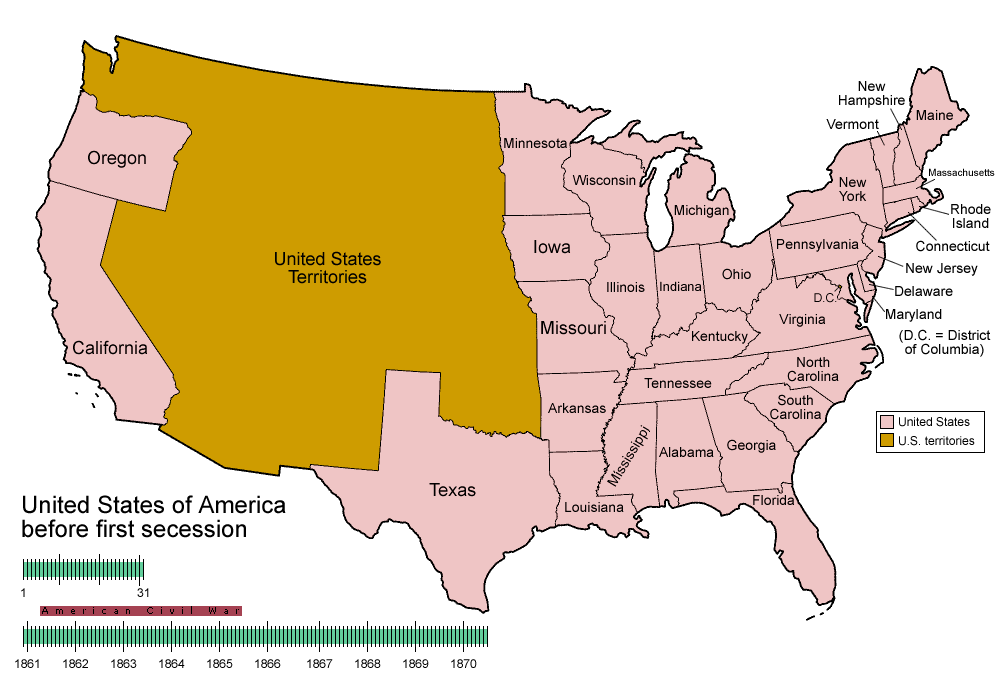
|
| Large High Resolution Map of Secession of Southern States |
Emancipation reduced the likelihood of intervention from Britain and France
on behalf of the Confederacy. In addition, the goal also allowed the Union to recruit African Americans for reinforcements, a resource that the Confederacy did not exploit until it
was too late. The Border States and War Democrats initially opposed emancipation, but gradually accepted it as part of total
war needed to save the Union.
By 1864, long-term Union advantages in geography, manpower, industry, finance,
political organization and transportation were overwhelming the Confederacy. Grant fought a number of bloody battles with
Lee in Virginia during the summer of 1864. Lee's defensive tactics resulted in extremely high casualties for Grant's army,
but Lee lost strategically overall as he could not replace his casualties and was forced to retreat into trenches around the
Confederacy's capital, Richmond, Virginia. Meanwhile, General William Sherman, the leader of the Union Military Division of
the Mississippi, captured Atlanta, Georgia, during his March to the Sea. Sherman also destroyed a hundred-mile-wide
swath of Georgia. In 1865 the Confederacy collapsed after Lee surrendered to Grant at Appomattox Court House. See also American Civil War: A Short History.
All slaves in the Confederacy were freed by the Emancipation Proclamation, which stipulated that slaves in Confederate-held areas, but not in Border States or
in Washington, D.C., were free. Slaves in the Border States and Union-controlled areas in the South were freed by state action
or by the Thirteenth Amendment, although slavery effectively ended in the United States in the spring of 1865. The full restoration
of the Union was the work of a highly contentious postwar and aftermath era known as Reconstruction.
Although more than 10,500 battles and skirmishes occurred during the U.S. Civil War, 384 engagements
(3.7 percent) were identified as the principal battles and classified according to their historical significance. Diseases and Napoleonic Tactics, consequently, were the contributing factors for the high casualties during the Civil War. See American Civil War History, Facts, and Statistics.
The war produced an estimated 1,030,000 casualties (3% of the population),
including approximately 620,000 620,000—two-thirds by disease. The grand total of 1,030,000 casualties, or
3% of the U.S. population, would equate to nearly 9,000,000 souls according to the 2010 U.S. Census. Let's take a moment
and think about it on today's terms. To put it into perspective, 3% of the U.S. population equates to the combined population
of the present-day states of New Hampshire, Hawaii, Rhode Island, Montana, Delaware, South Dakota, Alaska, North Dakota, Vermont
and Wyoming. See Civil War Comparison of North and South, Union and Confederacy.
The war accounted for more casualties
than all previous U.S. wars combined. Presently, the causes of the war, the reasons for its outcome, and even the name
of the war itself are subjects of lingering controversy. The main result of the war was the restoration of the Union.
Also, approximately 4 million slaves were freed in 1865. Based on 1860 United States census figures, 8% of all white males
aged 13 to 43 died in the war, including 6% in the North and an extraordinary 18% in the South. See also American Civil War Battles,
Casualties, & Statistics and Organization of Union and Confederate Armies.
| American Civil War History |
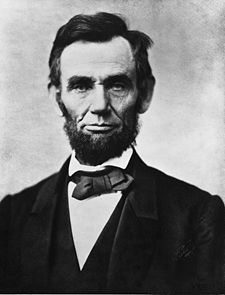
|
| President Abraham Lincoln & Civil War |
| American Civil War History |

|
| U.S. Civil War deaths or killed compared to other wars |
(The American Civil War accounted for more
deaths and killed [casualties] than all previous U.S. wars combined.)
Inventions
Numerous inventions and innovations were a result of the
Civil War. The arts of tactics and strategy were revolutionized by the many developments introduced during the 1860's. Thus
the Civil War ushered in a new era in warfare with the: first practical machine gun, first repeating rifle used in combat,
first use of the railroads as a major means of transporting troops and supplies, first mobile siege artillery mounted on rail
cars, first extensive use of trenches and field fortifications, first large-scale use of land mines, known as "subterranean
shells", first naval mines or "torpedoes", first ironclad ships engaged in combat, first multi-manned submarine, first organized
and systematic care of the wounded on the battlefield, first widespread use of rails for hospital trains, first organized
military signal service, first visual signaling by flag and torch during combat, first use of portable telegraph units on
the battlefield; first military reconnaissance from a manned balloon, first draft in the United States, first organized use
of Negro troops in combat, first voting in the field for a national election by servicemen, first income tax—levied
to finance the war, first photograph taken in combat, first Medal of Honor awarded an American soldier. See also Civil
War Comparison of the North and South.
The contributions to medical care that developed during the Civil War have not been fully
appreciated, probably because the quality of care administered was compared against modern standards rather than the standards
of the time. The specific accomplishments that constituted major advances were as follows: 1) Accumulation of adequate records
and detailed reports for the first time permitted a complete military medical history. This led to the publication of the
Medical and Surgical History of the War of the Rebellion, which was identified in Europe as the first major academic accomplishment
by U.S. medicine. 2) Development of a system of managing mass casualties, including aid stations, field hospitals, and general
hospitals, set the pattern for management of the wounded in World War I, World War II, and the Korean War. 3) The pavilion-style
general hospitals, which were well ventilated and clean, were copied in the design of large civilian hospitals over the next
75 years. 4) The importance of immediate, definitive treatment of wounds and fractures was demonstrated and it was shown that
major operative procedures, such as amputation, were optimally carried out in the first 24 hours after wounding. 5) The importance
of sanitation and hygiene in preventing infection, disease, and death among the troops in the field was demonstrated. 6) Female
nurses were introduced to hospital care and Catholic orders entered the hospital business. 7) The experience and training
of thousands of physicians were upgraded and they were introduced to new ideas and standards of care. These included familiarity
with prevention and treatment of infectious disease, with anesthetic agents, and with surgical principles that rapidly advanced
the overall quality of American medical practice. 8) The Sanitary Commission was formed, a civilian-organized soldier's relief
society that set the pattern for the development of the American Red Cross.
| Civil War Inventions in Science and Technology |
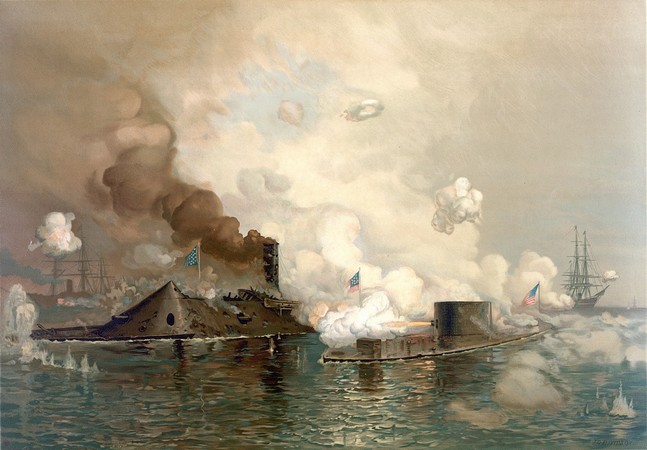
|
| Battle of Hampton Roads witnessed the first battleship duel in world history... |
| First Gatling Gun |
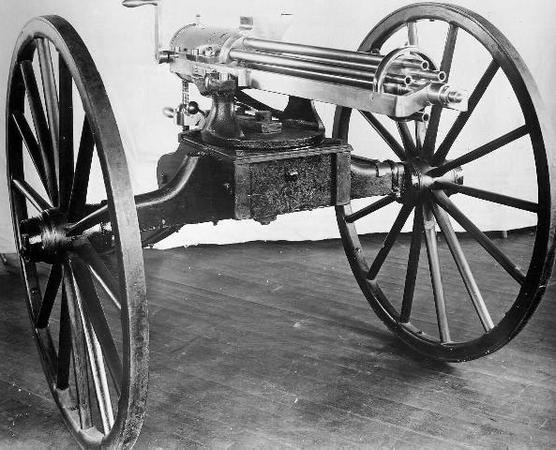
|
| Model 1862 Gatling Gun had a rate of fire of 200 rounds per minute |
(Left) Gatling hoped that by creating his devastating gun it would deter
nations from engaging in war, but the opposite proved true and more men died because of his rapid fire weapon. The Gatling
gun is one of the best-known early rapid-fire weapons and a forerunner of the modern machine gun. Invented by Dr. Richard
Gatling, it is known for its limited use by the Union Army during the Civil War. Designed in 1861 and patented on
November 4, 1862, the Model 1862 allowed unskilled soldiers to achieve a relatively high rate of fire of 200 rounds
per minute. The War Department believed that any rapid fire gun was only a weapon that would waste
the government's already strained supply of ammunition. Only two of the guns were employed near Petersburg and eight
were fitted on gunboats. The gun was not accepted by the U.S. Army until 1866. (Right) The first ironclad gunboat battle in
history. The USS Monitor (R) fought the CSS Virginia (L) to a stalemate on March 9, 1862, but the duel
forever changed naval warfare.
As a result of Civil War, many scientific and medical advances were made,
including the creation of the U.S. Sanitary Commission, U.S. Ambulance Corps, and American Red Cross. The U.S. and C.S. Navies
created waves on every continent when the ironclad warships USS Monitor and CSS Virginia engaged in the
world's first battleship duel at Hampton Roads on March 9, 1862, making every ship of the line obsolete. The present-day blue water navy is a product of the Monitor-Virginia
fight and their battle-proven armor, armament, and steam engines.
The majority of ironclads were steam powered, and most were designed
with a shallow draft, making them harder to hit. Builders made ironclads partially of wood, which they then covered with iron
plating. These vessels represent the transition from wooden, sail-powered ships to completely metal, steam-powered
ships. While heavy breech-loading guns underwent extensive trials, research and development during the Civil War, the
breech was not fully appreciated until the 1880s, causing navies to begin retiring their now outdated muzzle-loaders.
The USS Monitor was an iron-hulled steamship built during the
Civil War, and she was the first ironclad warship commissioned by the Union Navy. Monitor was the most innovative
design by virtue of its low freeboard, shallow-draft iron hull, and total dependence on steam power. The top of the armored
deck was only about 18 inches above the waterline.
The CSS Virginia was built by the Confederate States Navy during the first year of the Civil War.
She was constructed as a casemate ironclad using the original lower hull and engines of the scuttled steam frigate USS Merrimack.
Since Virginia was a steam-powered battery and not an ocean-going cruiser, she was not seaworthy enough to enter
the Atlantic, even if she were able to pass the Union Blockade. Virginia was also unable to retreat further up the James River due to her deep 22-foot draft. On March 8, 1862,
The slow moving Virginia attacked the Union blockading squadron in Hampton Roads, Virginia, destroying the sail frigates
Cumberland and Congress, and the steam frigate USS Minnesota ran aground while attempting
to engage Virginia, and remained stranded throughout the battle.
One of the most significant advances in weaponry was transitioning from smooth-bore to rifled weapons.
Rifling consisted of spiral grooves cut into the weapon’s barrel. The projectile engaged those grooves when the weapon
was fired, making the projectile spin, similar to a football, as it flew through the air. Rather than firing a round
ball from the smoothbore cannon (like those used in the Revolutionary War), rifled weapons fired a conical bullet. These conical
bullets proved much more accurate and could hit targets at a greater distance. For instance, a smoothbore musket was accurate
to about 80 yards, but a rifled musket was accurate to 300 yards or more. Battlefield tactics did not change with this increase
in accuracy, however. Most Civil War officers continued to instruct their men to hold their fire until the enemy was within
100 yards—making the rifled musket a much deadlier weapon.
Rifles had existed for well over a century before the Civil War, but the weapons were used primarily
for hunting instead of military application. In previous wars, riflemen were utilized as sharpshooters. Although the U.S.
Army had adopted rifled muskets in 1855, the Confederate Army initially used a variety of weapons, but employed rifled
muskets as they became available.
Armies first used rifled cannons, or artillery pieces, in the Civil War, and because of their increased
range and accuracy, rifled pieces made an entire generation of forts obsolete. Brick and masonry forts such as Fort Macon,
constructed between 1826 and 1834, had been built to withstand bombardment by smoothbore cannons. Rifled cannons firing larger,
heavier projectiles with greatly increased accuracy could breach such fortifications rather easily. To counteract rifled cannons
during the Civil War, crude earthen forts constructed of dirt, such as Fort Fisher and Fort Anderson, became bulwarks of choice.
Earthen forts could simply absorb incoming artillery shells and better protect the men and material inside. Earth
works and earthen forts were attacked in two manners: mortars in siege application; or massed infantry assault. Although siege
operations could last for months, it was preferred when the infantry assault was deemed unlikely to succeed or result
in high casualties outside of acceptable losses. Vicksburg and Richmond-Petersburg are two examples of successful Union siege operations. See Civil War Artillery and Cannon: Field, Garrison
and Siege, and Seacoast.
The Gatling gun, aerial reconnaissance, naval mines and torpedoes, and
trench warfare were born out of the war. Naval mines were developed by the Confederates to counter the Union's blockades of
Southern ports. Mines and later, torpedoes, were very effective sinking 40 Union ships. The success
of these mines led to the creation of land mines and grenades that would be used in later wars.
| Ruin, Rubble, Reconstruction, and Rebuilding |
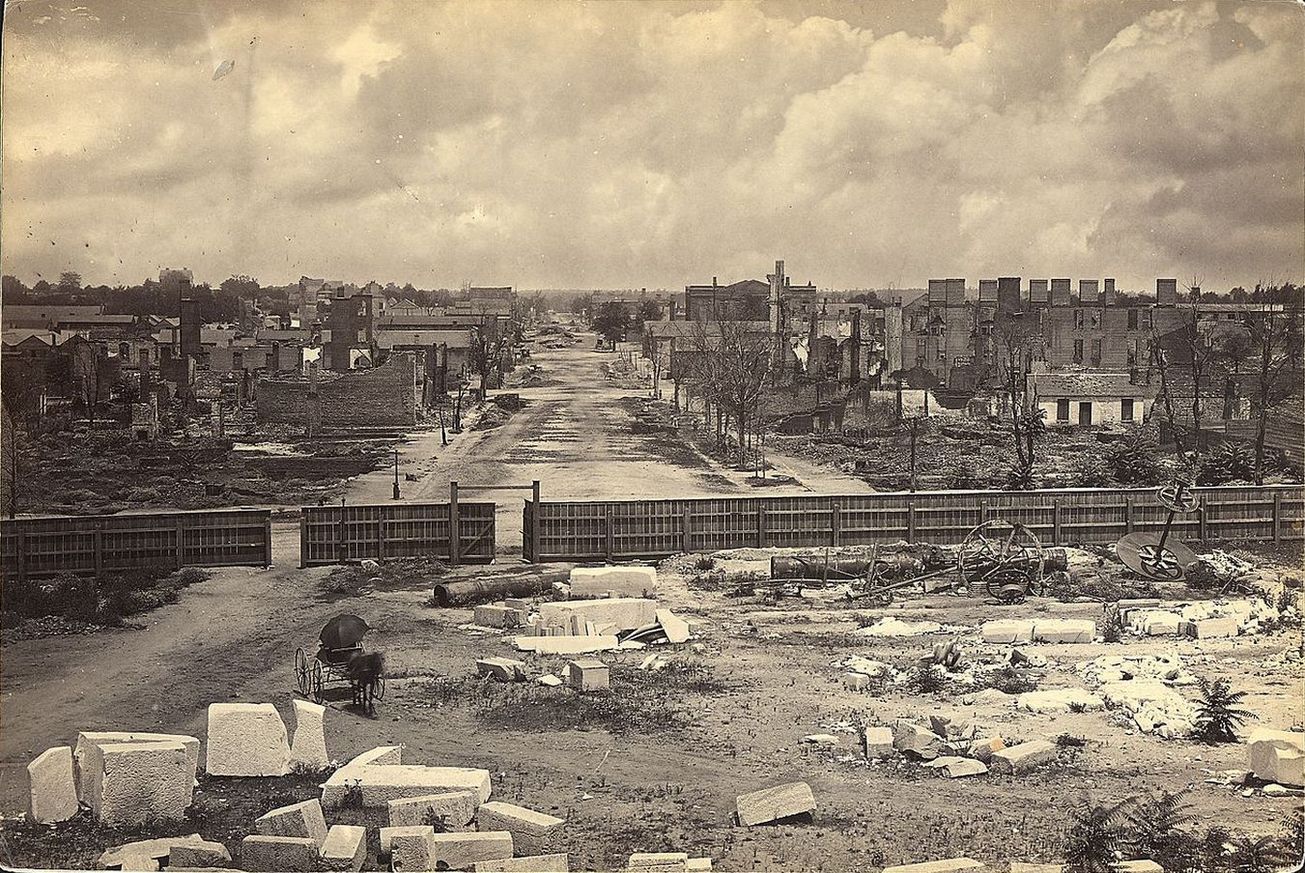
|
| Columbia, SC, during Reconstruction-- a familiar scene throughout Southern cities during the era. |
Analysis
Whether studying American Civil War history or reading a summary about the
conflict, the subject is fascinating not only because of the handsome Union and Confederate uniforms and those dashing generals
such as "Stonewall" and Custer, but coupled with the Homestead Act of 1862, the Wild West was born, and the likes of the James-Younger
Gang, for example, unleashed a swath of terror and destruction during the conflict's aftermath. The West was populated at
an unprecedented rate during Reconstruction (1865-1877), as many families sought their new beginnings out West. A question
often asked is whether the origin of the war was slavery or states' rights or a combination of causes. What caused the Civil
War? The subject has been debated since the first shots were fired. The student is encouraged to read the speeches
and letters of Lincoln, for he was also the commander-in-chief and stated his purpose candidly for mobilizing 75,000 troops in April 1861.
Based on 1860 census figures, 8% of all white males aged 13 to 43 died
in the Civil War, including 6% in the North and 18% in the South. Approximately 56,000 soldiers died in prison camps, while
an estimated 60,000 men lost limbs in the conflict.
Confederate death toll estimates vary considerably due to lack of records.
Union army deaths, amounting to 15% of the over two million who served, was as follows:
- 110,070 killed in action (67,000) or died of wounds (43,000)
- 199,790 died of disease (75% of which was due to the war)
- 24,866 died in Confederate prison camps
- 9,058 killed by accidents or drowning
- 15,741 other/unknown deaths
- 359,528 total dead
Although black troops accounted for 10% of the Union death toll, they totaled
15% of Union deaths by disease but less than 3% of those killed in battle.
Losses were high for both sides, and a single battle during the Civil
War often produced more fatalities than the 2,000 soldiers killed during the Mexican-American War in 1846–48. One
obvious reason for the high number of battle deaths during the war was the use of outdated Napoleonic tactics, such as linear
formations, where soldiers marched in rank and file formation toward the enemy before halting and firing their
muskets at a distance of 50 to 100 yards. With the advent of more accurate rifled barrels, an average soldier could deliver
a crippling volley at distances of 300 yards. Technology accelerated during the war and it resulted in catastrophic casualties
because of the likes of repeating firearms such as the Spencer and Henry. See also Civil War Weapons,
Firearms, Small Arms, and Edged Weapons.
The wealth of the Confederate states was amassed in its 3.5 million
slaves, but when slavery was abolished, most Southern farms folded because of lack of manpower. Although slavery was
not the cause of the Civil War, according to President Lincoln himself, he, did, however, use his executive powers to
emancipate slaves in 1863. His actions were applauded by England and France, and it resulted in their withdrawal
of support for the Southern states-- which still embraced the institution of slavery. The Emancipation Proclamation
was followed by the Thirteenth Amendment, thus abolishing slavery forever.
The war destroyed much of the wealth that had existed in the South.
All accumulated investment in Confederate bonds was forfeited; most banks and railroads were bankrupt. Income per person in
the South dropped to less than 40% compared to that of the North, a condition that endured into the 20th century. Southern
influence in the Federal government, previously considerable, was greatly diminished
until the latter half of the 20th century. The full restoration of the Union was the work of a highly contentious postwar
era known as Reconstruction. See also American Civil War.
See also Order of Surrendering Confederate
Forces and Last Battle and
Final Surrender of the Civil War.
*Best estimates. Depending on the source, numbers vary.
Sources: National Park Service; Library of Congress; National
Archives and Records Administration; Official Records of the Union and Confederate Armies; Friedrich Engels, “On Rifled
Cannon," articles from the New York Tribune, April, May and June, 1860; William
F. Fullam & Thomas C. Hart, USN, Text-Book of Ordnance and Gunnery. Chapter IV Breech Mechanisms published by United States
Naval Institute, Annapolis MD, 1905; Spencer C. Tucker, Almanac of American
Military History [4 volumes], 2012; history.navy.mil; U.S. National Library of Medicine.
|

|

|

